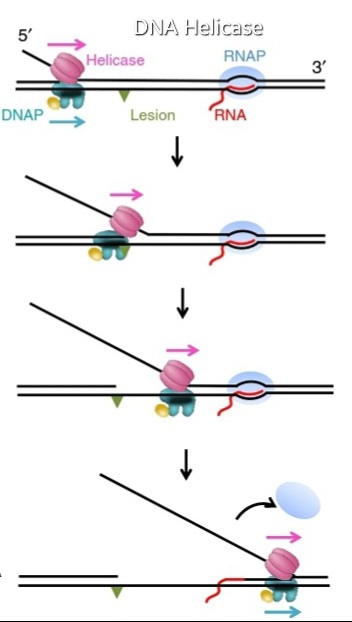博文
人类神经肌肉系统退行型三核苷酸重复DNA扩增的分子机制
||
越来越多的证据表明与人类神经肌肉系统退行型三核苷酸重复DNA扩增的分子机制与“RNA转录激活的局部DNA复制”有关
Recently accumulating evidence began to support the molecular expansion mechanism which was published in the year of 2006 in the journal of genetics and genomics, also known as Acta Genetica Sinica, previously (Pan 2006). The mechanism explains how the disease-associated trinucleotide repeats expand suddenly into deleterious long repeats. The key point of the mechanism is to propose an interrupted RNA transcription within repeats array formed a RNA:DNA hybrid, a.k.a an R-loop, ,which shared extraordinary similarities to the R-loop structure formed in the leading strand template orientation in a DNA replication fork, where a short RNA stretch attached to the DNA template, and is synthesized using a primase, rather than a conventional RNA polymerase.
It has been well documented that RNA transcription elongating along single stranded DNA template can easily be paused for many reasons, including encountering the cross-linked nucleotides, the bound proteins, such as histones, the damaged nucleotides, and the nonconventional DNA secondary structures, e.g. G-tetraduplex DNA, triple helical DNA, as well as DNA hairpins formed by the palindrome DNA , etc.
It should be noticed with that such transcription pausing could be found either in the leading or in the lagging strand transcription due to the single stranded DNA folding, or due to the RNA folding in the transcription bubble.
Nevertheless, in the case of trinucleotide repeats transcription, the elongation of the transcription can easily be disrupted by a the formation of nonconventional DNA structure as mentioned above, which could be seen either in the ongoing transcription template or in the non-template, the sense strand.
The stalled RNA transcription will release the halted RNA polymerase by DNA helicase and leave an RNA transcript bindings to the template DNA strand, forming a R-loop. This R-loop can then be utilized by DNA replication following a cSDR mode of DNA replication initiation, as normally be seen during the DNA replications of some bacterial plasmids, the mitochondrial DNA replication, and the telomere maintenance.
It has been a long time since the first publication of this RNA Transcription stimulated local repeat DNA replication mechanism, there was no known evidence that could potentially support the scenario described in humans, where the RNA left in the R-loop could turn to initiate a local DNA replication by converting a RNA transcription into a DNA replication.
This turns out to be the case as evidenced by the recent publications, which demonstrate that certain types of DNA helicase and RNase H could trim the RNA in the R-loop into a RNA primer, which is going to be used for restarting a DNA local replication, usually need to set up a real DNA replication fork as already be shown in different species, under this circumstances, the non-template strand of DNA has to be cleaved using nuoclease, e.g Mre11 etc, which eventually constitutes a local repeat replication event as being named as the RNA transcription stimulated local repeat replication upon a R-loop structure formation.



Questions Remain To be Answered
As shown in the table, the molecular details of the RNA transcription induced(stimulated)DNA replication restarting(local DNA replication restart) are still obscure in the in vivo setting. Many details remain to be mapped out, e.g. what types of structures once form by trinucleotide repeats could stall the RNA transcription, where are the exact locations the RNA transcription could be paused? What is the fine structure of the R-loop could be created by the stalled RNA transcription ? Which type of DNA helicase will be responsible for the release of the stalled RNA polymerase and for seting up the DNA replication initiation complex? And why the DNA replication fork could be set up as seen in the conventional DNA replication initiation? What is the DNA replicase that might be able to elongate the local DNA replication? and How long the DNA replication could be elongated?
Nevertheless, ongoing investigations that aimed to understand the mechanism of TIR have began to give supports on the existence of the TIR in trinucleotide repeats transcription, and the more detailed information of the TIR a.k.a the RNA transcription stimulated local repeat DNA replication, in the in vivo situations need to be mapped out in the coming years.
https://wap.sciencenet.cn/blog-218980-1403216.html
上一篇:关于启动“呼吸爆发”或“氧化爆发”机制的假说
下一篇:学峰诗选-当你老了